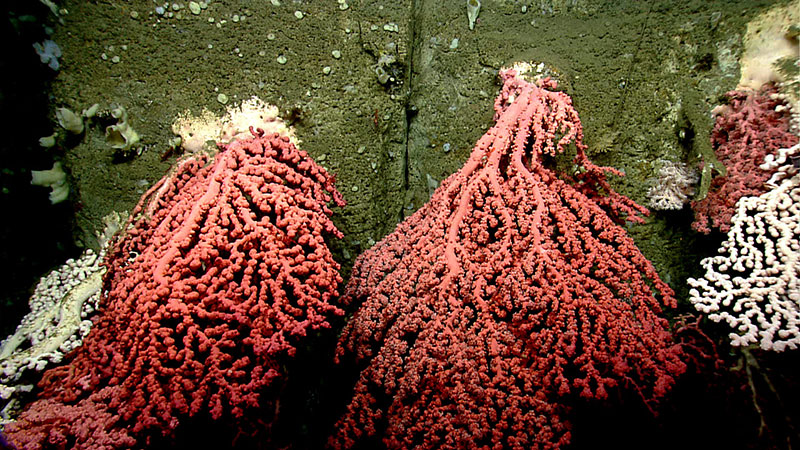Dive #9 was a shallow dive along the southwestern wall of Heezen Canyon. The remotely operated vehicle (ROV) was on bottom at 1315 UTC at 924 meters. The dive track started at an area with soft sediment and small rocks. The ROV transited up slope along a steep wall to the top, then along soft sediment and back down the northern part of a steep slope. The first rock feature was minimally encrusted by fauna, including sponges and anemones. At least 13 species of corals were observed either attached to the vertical face or on small rocks at the top of the slope, including: Anthomastus, unknown bamboo, Acanella, two species of cup corals, Solenosmilia, Paramuricea, Primnoa, Paragorgia, Acanthogorgia, Anthothela, Lophelia pertusa, and Clavularia. Shark egg cases were observed attached to Paramuricea, Paragorgia, and possibly bamboo coral. Fish species included Rhinochimaera, black dogfish, witch flounder, Sebastes, black belly rosefish, synaphobranchidae, ophidiidae, long fin hake, offshore hake, eelpout, hatchetfish (midwater), and mychtophidae (midwater). The steep slope was characterized by large rocks composed of mudstone or siltstone with cracks and thin to no sediment. Along the steep wall, chutes from possible turbidity flows were observed. Also, the geology of the dive track consisted of well exposed, but highly eroded (possibly Oligocene/Eocene age) outcrops, complex failure and sediment transport/canyon cutting morphologies, and another example of the possible relationship between lithology, sediment stability, and associated sessile encrusting organisms. The sediment-laden top was interspersed with various sized rocks, usually populated with small colonies of Acanthogorgia, with shrimp associates, and sponges. Highlights of the dive included the enormous Paragorgia, Primnoa, and Paramuricea colonies that were attached to the vertical face. Other corals were interspersed among these > two-meter colonies, including very large cup corals attached to the underside of ledges. Predation was also observed, including an eel eating a shrimp, a small fish (possibly midwater) attached to a solitary hydroid, and a fish escaping an octocoral. ROV was off bottom at 2006 UTC at 742 meters.
